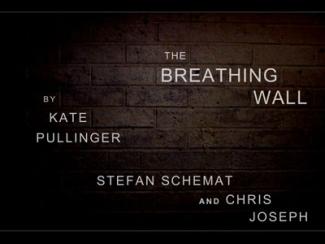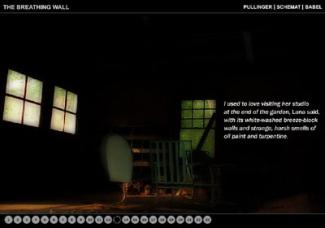Kate Pullinger’s […] cybertext The Breathing Wall, first presented at the 2004 trAce Conference at Nottingham Trent, undermines any theories of reader-response criticism which presuppose the reader’s intention as a major guiding principle in the construction of textual meaning. Like Bill Bly’s We Descend, it is one of the very few hypertexts defying the allegation that the detective story has never really entered hyperfiction. And indeed, The Breathing Wall departs from the rules of the conventional thriller by leaving the solution of the mystery not to the reader’s intention-driven, cognitive interplay with the plot, but to his or her very physical condition at the time of reading. The programmed ‘machine’ does in fact take control over significant stretches of the text. Particularly in the ‘daydreams’, large amounts of textual material are presented to the reader as a sequence of filmic text lexias, which do not give readers an opportunity to choose their own speed of reading but appear and disappear at a pre-programmed pace. The reader can move from subchapter to subchapter within a daydream, however, they lose control once the text film has started. A more controversial case of generic categorization is the Hyper Trans Fiction Matrix used for the dreams, which responds to the vegetative system of a breathing organism – which does not need to be human in nature. It is in fact the dreams which make The Breathing Wall one of the most interesting and forward-looking examples of cyberfiction. The Breathing Wall may, as it were, be considered a pilot example of ‘physio-cybertext’.
Generically, The Breathing Wall may be described as a neo-Freudian gothic detective novel, which combines a conscious, realistic level with an unconscious, supernatural world in much the same way as the American film romance Ghost (directed by Jerry Zucker and launched in 1990) does. The cybertext consists of two key components: a hypertext-based, largely sequential narrative, organized into five parts, or ‘daydreams’, and a set of ‘dreams’, which reveal the protagonist Michael’s nightly conversations with his late girl-friend, Lana. The story opens with Michael, who has been in prison for six months over allegations of having murdered Lana, a crime which he did not commit, yet for which he cannot provide a satisfactory alibi. The hypertext story reveals Michael’s frustration over his hopeless situation. In his (waking) dreams, Lana speaks to him, giving him clues as to what really happened. She suggests that he should consult his sister Florence, her best friend, who, despite her suspicions, decides to help her brother. She finds out that Lana was killed by her own father in one of his psychopathic fits. The last daydream is set after Michael’s release, as he converses with Lana at the cemetery, under a cherry tree. Whereas the hypertext sequence serves to reveal the gist of the detective story, the essential detail can only be obtained from the dreams, the reading of which requires utter patience, calm, and the appropriate breathing rate and depth.
Bizarre as it may sound, the speed and intensity of information transfer during Michael’s ‘dreams’ is entirely dependent on the reader’s respiratory mechanism. The breathing rate is measured by means of a run-of-the-mill microphone, attached to a headset and placed directly underneath the reader’s nostrils. The software used to transfer the measured data to the computer is called Hyper Trans Fiction Matrix, and was especially created for Kate Pullinger’s project by the German software programmer Stefan Schemat, whose responsibilities were, according to the credits, ‘hypnotic lyrics, programming, sound & vision of the dreams’. Babel created the hypertext, on which the ‘daydreams’ are based, and the background sound to them. Whereas the sound in the ‘daydreams’ serves purely decorative purposes, the ‘dream’ voices, read by Mufrida Hayes and Harry Capehorn, are in fact crucial to understanding the dialogues between the two main characters, as no written information is revealed in their subconscious conversations.
The Breathing Wall owes its attractiveness to a variety of things. Visually and auditorily, a lot of effort and attention to detail went into creating an enticing user interface. Background images, colours and sounds change frequently, giving the work an synaesthetic aura akin to film. However, text remains the decisive medium of information retrieval. Reading and listening are the two major receptive activities undertaken by the perceiver. Nevertheless, for experienced and unexperienced readers alike, the most important aspect is the overriding physical impression of finding their respiratory apparatus in harmony with that of the protagonist, thus establishing a previously unknown degree of identification. Michael is told by Lana to ‘sleep’, ‘breathe’, ‘feel [his] lungs’, and ‘dream’ [Daydream 2]. These instructions are meant for him as well as for the reader in order to intensify their reading and listening experience.
At the time of writing this study, only very few reviews of The Breathing Wall were yet available either in print or online. One exception is Picot’s review at The Hyperliterature Exchange, who coins the term ‘hyperventiliterature’ for the Pullinger’s work. At the aforementioned trAce Conference, the large number of people wanting to do a test session and buy a copy of the CD-ROM shows how great the acclaim was – and may be in future –, at least among hypertext and New Media experts.
This entry has been adapted from Astrid Ensslin: Canonizing Hypertext: Explorations and Constructions. London: Continuum 2007, pp. 111-112.


